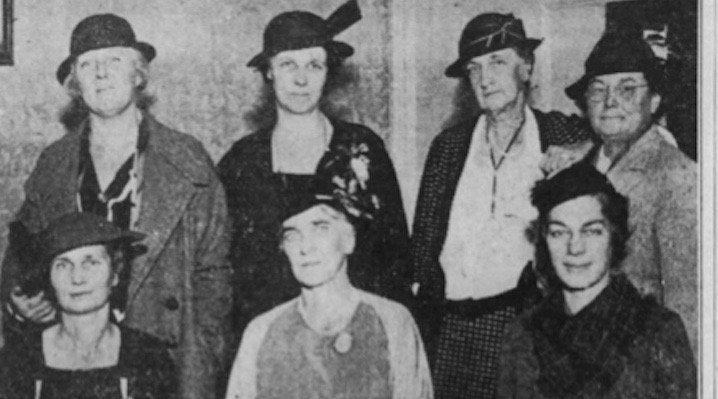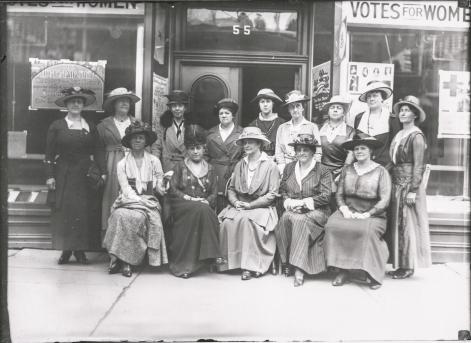
HISTORY OF THE LEAGUE OF WOMEN VOTERS OF CONNECTICUT
Read this February 2021 blog post about the early leaders in LWVCT's history:
Notable LWVCT Leaders 100 years ago
LWVCT Early History
 The National League of Women Voters is an outgrowth of the suffragist movement. Carrie Chapman Catt in 1919 recommended the National American Women Suffragist Association transform into the National League of Women Voters.1 The organization was founded in 1920 only six months before the 19th amendment to the United States Constitution was ratified, giving women the right to vote. The league began as a "mighty political experiment" designed to help 20 million women carry out their new responsibilities as voters. It encouraged them to use their new power to participate in shaping public policy. The national organization soon stimulated the formation of state leagues that in turn developed local ones.
The National League of Women Voters is an outgrowth of the suffragist movement. Carrie Chapman Catt in 1919 recommended the National American Women Suffragist Association transform into the National League of Women Voters.1 The organization was founded in 1920 only six months before the 19th amendment to the United States Constitution was ratified, giving women the right to vote. The league began as a "mighty political experiment" designed to help 20 million women carry out their new responsibilities as voters. It encouraged them to use their new power to participate in shaping public policy. The national organization soon stimulated the formation of state leagues that in turn developed local ones.
Founding of the Connecticut League of Women Voters and First Year, 1921
The Connecticut League of Women Voters (CLWV) was founded at New Haven, Connecticut on January 18, 1921.2 The league was formed as the initiative of the Connecticut Woman Suffrage Association (CWSA) came to an end with ratification of the 19th amendment. The reason for organizing the league was "to form a non-partisan organization which would 'develop a high quality of intelligence and self-directing activity in the woman voter and a program of legislation.' " At the founding meeting members adopted a constitution and by-laws; elected officers; and adopted a budget of $15,000 dollars.4 Ms. Mabel C. Washburn of Hartford was elected the first president of the CLWV.5 Chairman Maud Wood Park of the National League of Women Voters welcomed the new Connecticut members and urged them to pressure there congressmen for passage of the Shepard-Towner Bill to provide maternal and infant care education.6 In the first year local and county leagues were established; the newly elected state league board held meetings and determined that being independent from other organizations would benefit the league; and began plans for a Citizenship School at Yale University.
The league in its first year established a state program by forming seven standing committees. The following is a list of the first standing committees: Committee on American Citizenship; Committee on Legal Status of Women; Committee on Election Laws and Methods; Committee on Food Supply and Demand; Committee on Social Hygiene; Committee on Child Welfare; and the Committee on Women in Industry. Each state standing committee had a chairman which enlisted members to study issues related to the committee's subject area and prepare materials for publication and distribution. The committees also studied proposed legislation by the Connecticut General Assembly in there subject area and reported recommendations for action to the Executive Board of the CLWV. The board used the reports for action from committees to decide whether to support or oppose a particular piece of legislation.8 The positions of the league on potential or particular legislation before the General Assembly was provided to members through publications, local league meetings, annual conventions, and correspondence.
Legislative Bulletin and the National and State Programs of Work, 1921-1940
The Connecticut League of Women Voters (CLWV) on February 14, 1921 published its first Legislative Bulletin as a way to assist members in understanding the legislative issues being worked on by the CLWV in the General Assembly. The first Legislative Bulletin focused on bills in the General Assembly pertaining to civil service and social hygiene. The Legislative Bulletin, later renamed the Woman Voter's Bulletin and Connecticut Voter, provided information on legislative issues being worked on by the CLWV in the General Assembly; the state program presented by the standing committees at the annual conventions and voted on by delegates; announcements by the state, county and local leagues; fiscal reports; election education and information; candidate statements; political party platforms; occasional photographs; and relevant news items related to the program or objectives of the league. The proposed, passed, and revised national and state programs along with state convention highlights were consistently published in the leagues newsletters.
The Connecticut League of Women Voters state conventions determined what parts of the National League of Women Voters program of work would be included in the biennial state program of work. The topics studied and acted on by the CLWV throughout the 1920s and 1930s focused on the following: jury service for women, child welfare, social hygiene, widow aid, efficient government, reorganization of state government, civil service, education, labor, international affairs, international cooperation to prevent war, pollution, Native Americans, taxation, living costs, unemployment compensation, social security, food and drug safety, immigration, law enforcement, legal status of women, and women in industry. The study and action topics of jury service for women and a state constitutional convention would occupy a large part of the Connecticut League of Women Voters continuing responsibilities under state programs from 1921-1965.
LWVCT Through the Years
Enjoy this special presentation that shares more history through the years from the special display at the Capitol for the LWVCT 90th celebrations in 2010: "Marching in Their Footsteps" by Elisa McCarthy and Carole Mulready of the League of Women Voters of Connecticut.